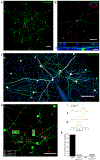A Self-Regulating Gap Junction Network of Amacrine Cells Controls Nitric Oxide Release in the Retina
- PMID: 30482690
- PMCID: PMC6317889
- DOI: 10.1016/j.neuron.2018.09.047
A Self-Regulating Gap Junction Network of Amacrine Cells Controls Nitric Oxide Release in the Retina
Abstract
Neuromodulators regulate circuits throughout the nervous system, and revealing the cell types and stimulus conditions controlling their release is vital to understanding their function. The effects of the neuromodulator nitric oxide (NO) have been studied in many circuits, including in the vertebrate retina, where it regulates synaptic release, gap junction coupling, and blood vessel dilation, but little is known about the cells that release NO. We show that a single type of amacrine cell (AC) controls NO release in the inner retina, and we report its light responses, electrical properties, and calcium dynamics. We discover that this AC forms a dense gap junction network and that the strength of electrical coupling in the network is regulated by light through NO. A model of the network offers insights into the biophysical specializations leading to auto-regulation of NO release within the network.
Keywords: Connexin-45; NOS; amacrine cell; gap junctions; light adaptation; nNOS; nNOS-2; nitric oxide; retina.
Copyright © 2018 Elsevier Inc. All rights reserved.
Figures








References
-
- Badea TC, and Nathans J (2004). Quantitative analysis of neuronal morphologies in the mouse retina visualized by using a genetically directed reporter. J. Comp. Neurol 480, 331–351. - PubMed
-
- Benda J, Bock R, Rujan P, and Ammermüller J (2001). Asymmetrical dynamics of voltage spread in retinal horizontal cell networks. Vis. Neurosci 18, 835–848. - PubMed
-
- Berson DM, Dunn FA, and Takao M (2002). Phototransduction by retinal ganglion cells that set the circadian clock. Science 295, 1070–1073. - PubMed
Publication types
MeSH terms
Substances
Grants and funding
LinkOut - more resources
Full Text Sources
Molecular Biology Databases
Miscellaneous

